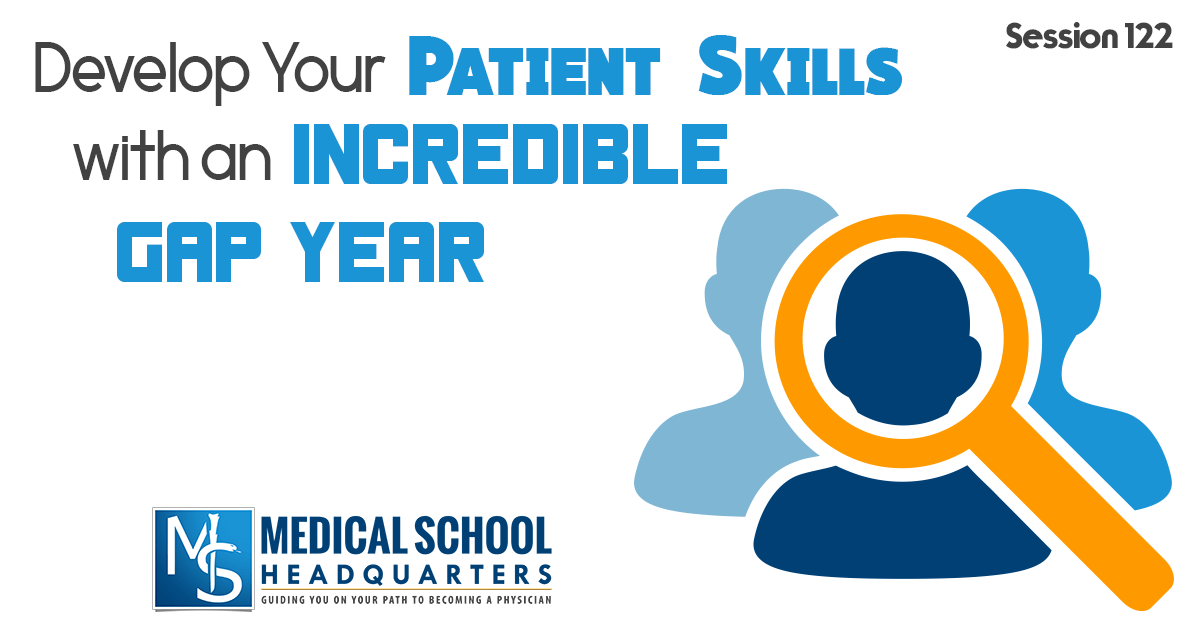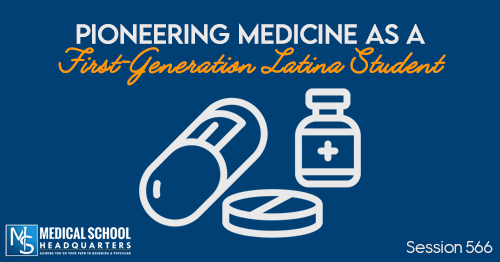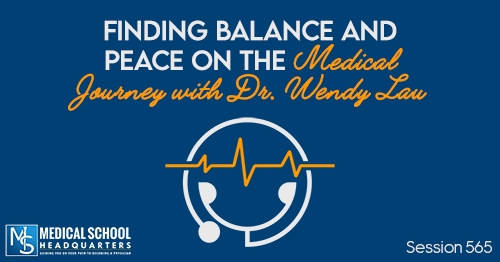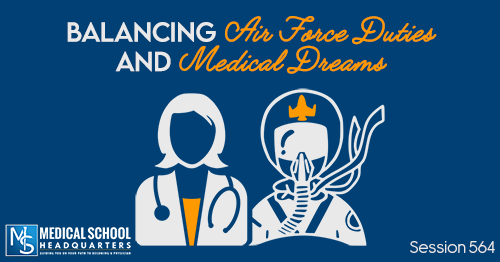Apple Podcasts | Google Podcasts
Session 122
 In this episode, I talk about gap years with Blake and Meg from The Center for Patient Partnerships, an interdisciplinary center dedicated to keeping patients front and center. For over 15 years, they’ve been an international leader for patient advocacy education.
In this episode, I talk about gap years with Blake and Meg from The Center for Patient Partnerships, an interdisciplinary center dedicated to keeping patients front and center. For over 15 years, they’ve been an international leader for patient advocacy education.
On top of this, they are also creating a curriculum about patients’ experiences with health and health care. They’re in the business of not only helping patients but health care providers and everyone involved in health care. They offer premed students a gap year opportunity to get a real experience interacting with patients.
Listen to this podcast episode with the player above, or keep reading for the highlights and takeaway points.
What is a Gap Year for Premed Students?
A gap year is a year between undergrad and medical school. I’m a huge believer in gap years, especially if you use it to get more clinical experience, because it helps you become more empathetic with patients. Clinical experience helps you understand what life is like for a lot of patients since you will be working all day, not on student’s schedule.
In short, gap years are beneficial. They give you the experience of what it’s really like to live in the world outside of being a student. Additionally, any jobs you have can add to the experiences you can list on your application.
Gap years give you the experience of what it’s really like to live in the world outside of being a student.Click To TweetHarvard Article about Gap Years Before Medical School
There was an article in The Harvard Crimson about Students Taking Time Off Before Applying to Medical School.
Robert Mayer, the faculty associate dean of admissions at Harvard Medical School, talked about how he’s been there for 11 years. He noted that when he started, 60% of matriculating medical students came straight out of college (traditional students).
65% of students starting medical school today have taken some time off before started medical school.Click To TweetEleven years later, that number has decreased to about 35%. Hence, 65% of students starting medical school today have taken some time off before started medical school.
The Origins of the Term “Gap Year”
- The term originated in Europe, where it refers to a gap year between high school and entering college.
- The meaning has expanded in the last few years with students taking a gap year between college and professional school.
Why Not Go Straight to Medical School After College?
- The average age of medical school entrance is now about 25 years old.
- A gap year allows you to:
- Get more experience
- Make sure you exactly know what you want to do in medical school
- Take some time off to travel
- Build up your GPA and get experiences needed for your application
[Related episode: What Jobs Should I Do During My Gap Year?]
What The Center for Patient Partnerships Is Doing to Give Patient Interaction to Premeds
- Opportunities to get the real patient perspective
- Learning about the intricacies of the health care system
- Learning about the patient’s side of the table
- Opportunities to work directly with patients
- Opportunities to learn how everything works before being fully responsible for the care of a patient
All About The Center for Patient Partnerships
- They are not affiliated with a hospital or health care provider or clinic.
- Patients come to them independently.
- They provide services independently.
- Patients are not charged for the services, but in exchange, they have to be willing to work with students and help them learn what it’s like to be a patient.
- They are an interdisciplinary center where other industries are involved (students, lawyers, social workers, pharmacists, etc), and you get to work with them.
The Inclusion of Social Sciences into the New MCAT
Clinical experiences with different social and cultural groups can enrich your ability to score on the social sciences on the MCAT since it’s been changed in 2015.
[Related episode: Should I Take Sociology to Prepare for the MCAT?]
A Day in the Life of a Student in the Center for Patient Partnerships Program
- Arrive and check mailboxes and messages to see if they have a new case
- Call the client or patient and read notes
- Meet with supervisor and discuss cases one by one
- Discuss strategy and next steps
- If they have a new case, they prepare and present on their advocacy strategy, client’s goals, information needed before execution, and what they hope to achieve.
- Sit together and talk about the cases and any developments
- Meet with the patient or client, accompany the patient to the doctor
- Help the patient define his/her team
- Students are the clarion call for the patient
- Facilitate conversations between patients and clinicians
Taking the Online Version of the Program
- Students from across the country can take the certificate without having to move to Madison, WI.
- They use multiple forms of media to connect with patients from across the country or even outside of the U.S.
More about their program:
- Class size of 10-14 students
- The importance of small class sizes in building a sense of community
- 3-day boot camp orientation before the clinical part
Two Online Courses for the Med Force
Advocating for Populations: a 4-week highly intensive course learning about advocacy in media, legislature, community, etc.
Advocating for Patients: a quick and dirty course about the health care system, clinician’s role, how to be an effective and efficient advocate, and developing an advocacy infrastructure in your practice
They have a class starting in the summer if you want to get started right away. Classes start on Tuesday, May 26, 2015. Classes in Fall start the day after Labor Day.
More Gap Year Ideas for Premeds
- Volunteering in hospitals
- Working in research labs, interacting with scientists, researchers, etc.
- Foreign travel health care assistance
- Taking the IPA (Introduction to Patient Advocacy) course as a stand-alone at The Center for Patient Partnerships to get a taste of what getting the certificate is like
[Related episode: What Are Some Good Gap Year Ideas?]
Some Pieces of Advice for Premed Students
To be an advocate for a patient will expose you to so many things you’ll never have exposure to as you’re going through medical school or residency. Take the time to learn about this opportunity. In the end, it will make you more informed and it will definitely improve your patient outcomes.
To be an advocate for a patient will expose you to so many things you'll never have exposure to as you're going through medical school or residency.Click To TweetLinks and Other Resources
- The Center for Patient Partnerships
- Check out my Premed Playbook series of books (available on Amazon), with installments on the personal statement, the medical school interview, and the MCAT.
- Related episode: What Is the Best Paid Clinical Experience for Med School?
- Related episode: Should You Take a Gap Year Before Medical School?
- Need MCAT Prep? Save on tutoring, classes, and full-length practice tests by using promo code “MSHQ” at Blueprint MCAT (formerly Next Step Test Prep)!











